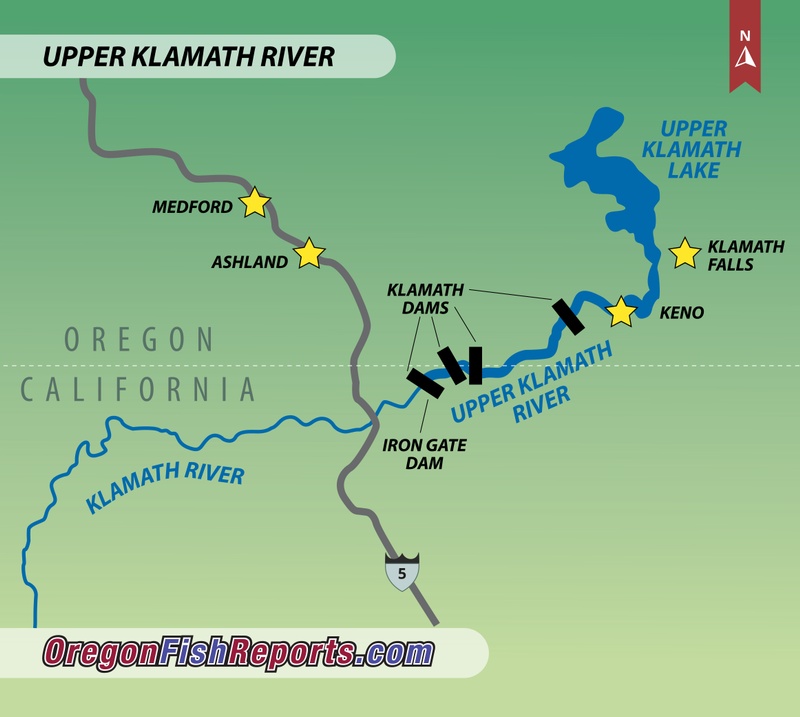Klamath River - Upper - OR Fish Report for 4-7-2022
Klamath River Fishing Report
Klamath River - Upper - OR

by OR Department of Fish & Wildlife Staff
4-7-2022
Website
Keno Dam to J.C Boyle Reservoir
Fishing is very slow. Most redbands are moving to spawning tributaries. Remember bait is not allowed and only one fish over 15 inches can be harvested per day. Also, remember that once you retain your one redband/rainbow trout limit you must stop fishing for redband/rainbow trout.
Flows (633 cfs) are low. Water temperature is ranging from 50-53 degrees. Large trout in this reach feed on the many fat head minnows and chub coming down from above Keno Dam. Few trout over 18 inches are being caught this fall. Flies and lures that mimic these minnows will be successful. Remember the Klamath River eats your fishing gear. Jig style hooks, heavy line and single barbless hooks can reduce the likelihood of losing a lot of gear.
This section of the river is very challenging fishing with white water and treacherous wading. The river is loaded with boulders and drop offs. ODFW recommends a wading staff, wading belt, excellent wading boots with studs, and maybe even a helmet and shin guards!
Public access is difficult, but you can drive a horrendous road to immediately below Keno Dam. All other sites require a significant hike to the river.
J.C. Boyle Dam to J.C Boyle Powerhouse
Open all year. Flows are low and stable and typically range from 100 cfs at the dam and increase due to to springs around 350 cfs at the Powerhouse. Catch rates should be good for this time of year. Fishing is best below the spring inputs. The springs start to discharge into the river approximately one mile below J.C. Boyle Dam. This section of river requires a hike down steep grade to the river except for the area just above the powerhouse.
Use small flies or lures as redband trout are mostly small (8-10 inches) in this section.
There is good access at the powerhouse. Park and walk upstream. This area is fished hard, but you can hike to get away from the pressure. Hiking or wading upstream is difficult. Small nymphs such as pheasant tails and prince nymphs work well in this section. Small black Panther Martins or Rooster Tails work well cast upstream into the deeper pools.
J.C. Boyle Powerhouse to State Line with California
Remains the best option for fishing in the Klamath Basin. Roads will be muddy. Make sure you have good tires and 4X4. Best fishing is when flows are less than 900 cfs. You can check flow estimates at PacifiCorp Weekly Flow Estimates. You can also call the flow line at 1-800-547-1501. Best fishing will be from 6 a.m. to 4 p.m. this week. Fishing can be relatively good for this time of year.
Look for blue winged olive mayflies hatching. They typically hatch from 12-4 p.m. Fishing small pheasant tails size 16-18 can be productive. Switching to dry flies can be productive as well. Look for rising fishing along the back eddy foam lines. Large attractor flies such and wooly buggers, bead head prince, and rubber leg stoneflies under a strike indicator work best this time of year. Olive and black wooly buggers almost always work well. Black spinners and Panther Martins can also work.
Below the JC Boyle Powerhouse the redband/rainbow trout get slightly larger than the aforementioned reach and average 12 inches but rarely exceed 16 inches. Currently, most redband caught are in the 10- to 14-inch range.
More Reports
OR Department of Fish & Wildlife Reports
for Thursday, April 7th, 2022: ODFW Recreation Report
Gerber Reservoir: The reservoir remains at 12 percent full
John C Boyle Reservoir: Fishing is improving for warmwater fish as they move into the shallows
Upper Klamath Lake: ishing is slow but will improve in late April

4-5-2022
THE DALLES, Ore.—ODFW has set the following regulations for a spring Chinook fishery on the Hood River: Open for adult hatchery...... Read More

Website Hosting and Design provided by TECK.net